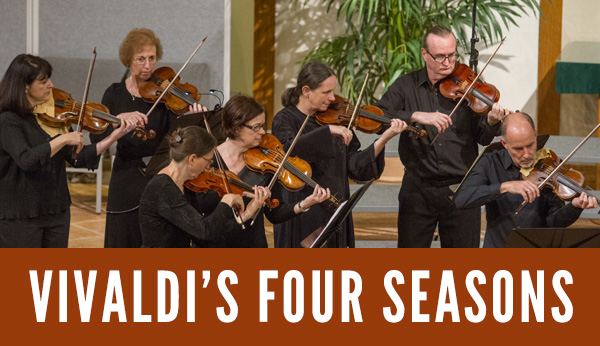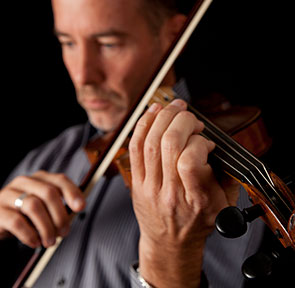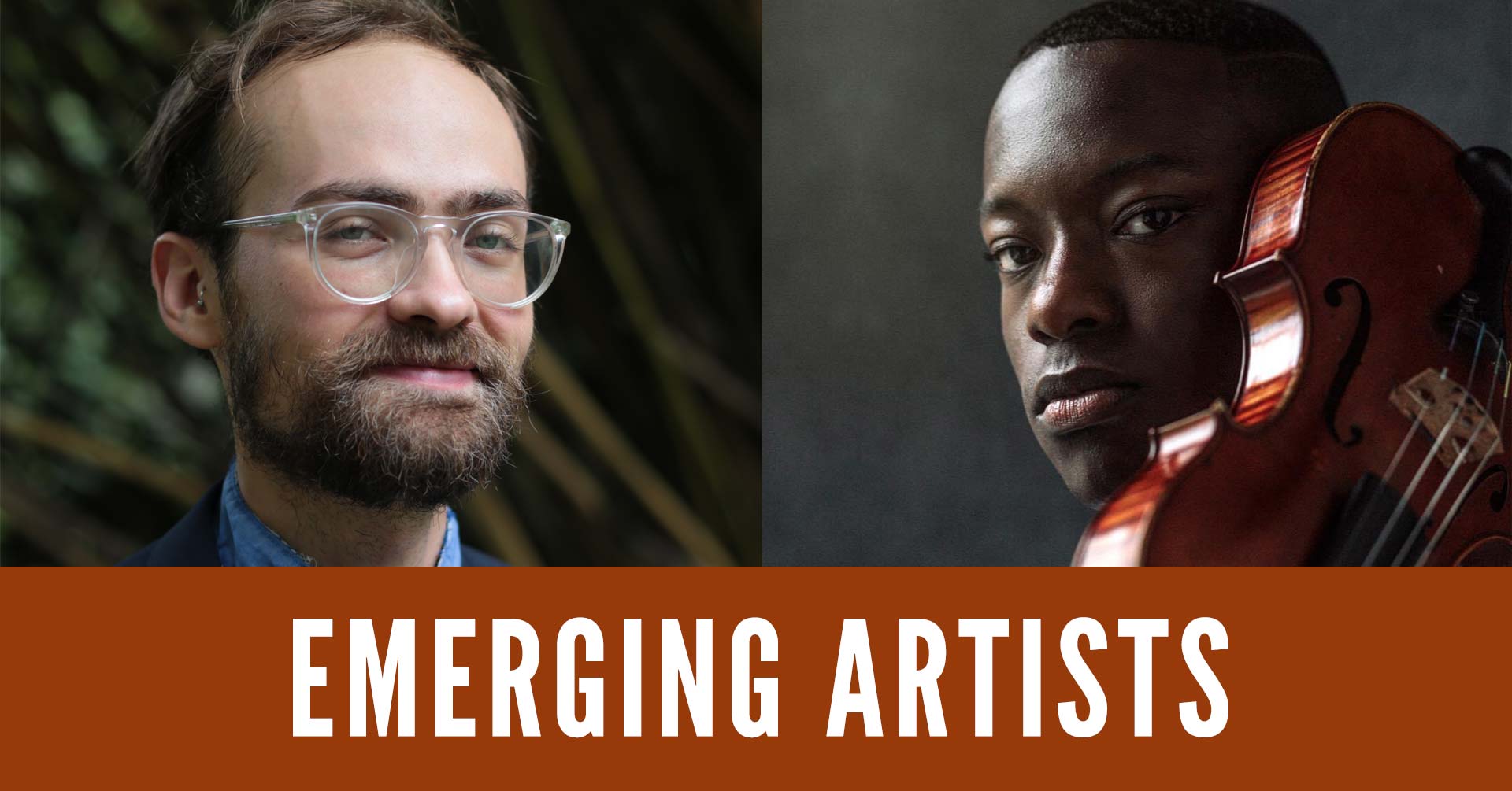VIVALDI’S FOUR SEASONS
Tuesday, June 8, 2021 | 7:30 PM
Victoria Fine Arts Center
1002 Sam Houston Drive
Le quattro stagioni (“The Four Seasons”), Op. 8, Nos. 1-4
La primavera (“Spring”), RV 269
Allegro—Largo—Allegro: Danza pastorale
L'estate (“Summer”), RV 315
Allegro non molto—Adagio—Presto
L'autunno (“Autumn”), RV 293
Allegro—Adagio molto—Allegro
L'inverno (“Winter”), RV 297
Allegro non molto—Largo—Allegro
Stephen Redfield, violin solo and leader
VBF Baroque Orchestra
Joan Carlson, violin
Bruce Colson, violin
Boel Gidholm, violin
Gesa Kordes, violin
Melissa Brewer, viola
Suzanna Giordano-Gignac, viola
Chris Haritatos, violoncello
Melanie Punter, violone
Mario Aschauer, harpsichord
Keith Womer, organ
Robert Posey, reader

Learn before you listenJoin us at 6:30 p.m. for a pre-concert talk with George Stauffer, Distinguished Professor of Music History at Rutgers University’s Mason Gross School of the Arts. |
 |
Sponsors
Alice & Gary Childress
This concert is generously supported by our concert sponsors and by donors to the Victoria Bach Festival’s Annual Fund. Many thanks to our generous supporters!
Padre Antonio Vivaldi was an innovator in ways that often go unrecognized. In an era where few women were encouraged to play instruments, most of his works were composed for the orphaned and unwanted girls in the combination convent, orphanage, music conservatory, and boarding school (ospedale) he ran in Venice. The fame of these young virtuosi infused Europe, as they mastered his still-challenging works, presenting them behind a screen for an audience of avid listeners.
But the works themselves are as revolutionary as the players. Not until the orchestral works of Berlioz was a composer able to write program music as effectively as the “Red Priest.” Not until the operatic works of Wagner was a composer able to effectively connect larger works with a common theme. These Romantic-era works from the 19th century appeared more than 100 years after Vivaldi’s Four Seasons, written in the 18th century.
The Four Seasons is a set of four violin concertos, each based on a season of the year, beginning with spring [primavera, “first greening”], followed by summer [estate], autumn [autunno], and winter [inverno]. Each has the standard concerto form of three movements—fast, slow, fast—with the characteristic Baroque feature of ritornelli, recurring themes for the orchestra, that alternate with the soloist.
But where these works break with tradition is in the inclusion of one sonnet per concerto. Each movement depicts part of the sonnet through a technique called “word painting.” Word-painting existed in the Renaissance, but it was used predominantly for vocal music. So, a merry lad running down the hill could be represented by a quickly descending scale. In Vivaldi’s Seasons, however, the words of the sonnet are never sung.
The sonnet, a poetic form developed in Renaissance Italy and made famous by such luminaries as Petrarch and Shakespeare, has features that complement the basic format of the concerto form. The natural three-part break in a sonnet’s subject matter could match the three-movement form. The Petrarchan sonnet consists of fourteen lines, an octet plus a sestet. The first eight lines traditionally make a statement or ask a question with a rhyme scheme of “abba abba.” The final six lines produce a response, counterargument, or clarification with a rhyme scheme “cde cde” or “cdc cdc.” Note that the poetic repetition resembles the ritornello concept. But Vivaldi approaches the sonnet divisions in varied ways.
In both Spring and Summer, the first movement covers the entire octet, while the second and third movements split the sestet evenly. Spring’s octet, for example, paints a scene of nature’s bliss. The second movement points to a specific feature, the sleeping shepherd; the third movement further clarifies the springtide dance fest. Summer’s octet has the birds singing and the breezes are stirring, but the shepherd is fearful. The second movement’s first three lines of the sestet clarify his fears and the third movement’s last three lines argue that his fears are justified.
For Autumn, the first and second movements share the octet, chronicling the celebrations at the close of harvest leading to well-deserved sleep, while the final movement sestet portrays the next morning when the hunt begins. Winter has yet another approach, discarding sonnet traditions. The first movement only addresses the first half of the octet, the teeth-chattering cold of a frigid winter day. The second movement deals with only two lines, the homely scene in front of a warming fire. To end the piece, the last two lines of the octet and all of the sestet are covered in the final movement of the cycle, returning to the view of uncomfortable iciness while still praising the delights of the season.
–Dr. Yvonne Kendall, © 2021
Vivaldi’s Four Seasons — Sonnets
Spring
Allegro
Giunt’ è la Primavera e festosetti
La Salutan gl’ Augei con lieto canto,
E i fonti allo Spirar de’ Zeffiretti
Con dolce mormorio Scorrono intanto:
Vengon’ coprendo l’ aer di nero amanto
E Lampi, e tuoni ad annuntiarla eletti
Indi tacendo questi, gl’ Augelletti;
Tornan’ di nuovo al lor canoro incanto:
Largo
E quindi sul fiorito ameno prato
Al caro mormorio di fronde e piante
Dorme ‘l Caprar col fido can’ à lato.
Allegro
Di pastoral Zampogna al suon festante
Danzan Ninfe e Pastor nel tetto amato
Di primavera all’ apparir brillante.
Summer
Allegro non molto
Sotto dura Staggion dal Sole accesa
Langue l’ huom, langue ‘l gregge, ed arde il Pino;
Scioglie il Cucco la Voce, e tosto intesa
Canta la Tortorella e ‘l gardelino.
Zeffiro dolce Spira, mà contesa
Muove Borea improviso al Suo vicino;
E piange il Pastorel, perche sospesa
Teme fiera borasca, e ‘l suo destino;
Adagio e piano – Presto e forte
Toglie alle membra lasse il Suo riposo
Il timore de’ Lampi, e tuoni fieri
E de mosche, e mossoni il Stuol furioso!
Presto
Ah che pur troppo i Suo timor Son veri
Tuona e fulmina il Ciel e grandioso
Tronca il capo alle Spiche e a’ grani alteri.
Autumn
Allegro
Celebra il Vilanel con balli e Canti
Del felice raccolto il bel piacere
E del liquor de Bacco accesi tanti
Finiscono col Sonno il lor godere
Adagio molto
Fà ch’ ogn’ uno tralasci e balli e canti
L’ aria che temperata dà piacere,
E la Staggion ch’ invita tanti e tanti
D’ un dolcissimo Sonno al bel godere.
Allegro
I cacciator alla nov’ alba à caccia
Con corni, Schioppi, e canni escono fuore
Fugge la belua, e Seguono la traccia;
Già Sbigottita, e lassa al gran rumore
De’ Schioppi e canni, ferita minaccia
Languida di fuggir, mà oppressa muore.
Winter
Allegro non molto
Aggiacciato tremar trà neri algenti
Al Severo Spirar d’ orrido Vento,
Correr battendo i piedi ogni momento;
E pel Soverchio gel batter i denti;
Largo
Passar al foco i di quieti e contenti
Mentre la pioggia fuor bagna ben cento
Allegro
Caminar Sopra ‘l giaccio, e à passo lento
Per timor di cader gersene intenti;
Gir forte Sdruzziolar, cader à terra
Di nuove ir Sopra ‘l giaccio e correr forte
Sin ch’ il giaccio si rompe, e si disserra;
Sentir uscir dalle ferrate porte
Sirocco Borea, e tutti i Venti in guerra
Quest’ é ‘l verno, mà tal, che gioja apporte.
Vivaldi Four Seasons — Sonnets
trans. Steven Ledbetter
Spring
Allegro
Spring has arrived,
and merrily the birds greet it with happy song;
and the brooks, at the breath of Zephyrs,
With sweet murmuring rush along.
Then, covering the air with a black cloak,
come lightning and thunder selected to herald it,
then, when they are silent,
the little birds return anew to their melodious enchantment.
Largo
And now in the pleasant flowery meadow,
To the soft murmur of boughs and grasses,
Sleeps the goatherd, his faithful dog at his side.
Allegro
To the festive sound of pastoral bagpipes
Nymphs and Shepherds dance under their beloved sky
At Spring’s sparkling arrival.
Summer
Allegro non molto
In the harsh season, parched by the sun,
man and flock languish, and the pine withers.
The cuckoo raises its voice and, when it’s heard,
the turtledove and goldfinch sing.
Zephyr blows sweetly, but, in contest,
Boreas suddenly moves nearby;
and the shepherd boy weeps, for, in suspense,
he fears the violent storm and his own fate.
Adagio e piano – Presto e forte
His weary limbs are deprived of rest
By fear of lightning and wild thunder,
and by the furious swarm of flies and bluebottles!
Presto
Unfortunately his fears are justified.
The sky fills with thunder and lightning,
And hail decapitates the proud stalks of grain.
Autumn
Allegro
The peasant celebrates with dance and song
the pleasures of the happy harvest.
And glowing with the wine of Bacchus,
many end their merrymaking with sleep.
Adagio molto
The mild air that gives such pleasure
causes all to leave off dancing and singing;
It is the season that invites all and sundry
to the fair delights of sweet sleep.
Allegro
The hunters, a-hunting at dawn,
set out with horns, guns, and hounds.
The beast flees, they follow its tracks.
Already terrified and exhausted from the noise
of the guns and hounds,
the wounded creature tries weakly to flee, but is overcome and dies.
Winter
Allegro non molto
Trembling, frozen, in the icy snow,
at the horrid wind’s harsh breath,
Running while constantly stamping one’s feet,
and feeling the teeth chatter from the overwhelming cold.
Largo
Passing quiet and contented days by the fire
while outside the rain soaks people by the hundreds;
Allegro
Walking on the ice with slow steps
for fear of falling, turning cautiously
Turning suddenly, slipping, falling down,
going on the ice again and running fast until the ice breaks open;
Hearing, as they burst through the bolted doors,
Sirocco, Boreas, and all the winds at war.
This is winter, and it brings such joy!
Vivaldi’s Four Seasons: The Poetry Behind the Music
Padre Antonio Vivaldi was an innovator in ways that often go unrecognized. In an era where few women were encouraged to play instruments, most of his works were composed for the orphaned and unwanted girls in the combination convent, orphanage, music conservatory, and boarding school (ospedale) he ran in Venice. The fame of these young virtuosi infused Europe, as they mastered his still-challenging works, presenting them behind a screen for an audience of avid listeners.
But the works themselves are as revolutionary as the players. Not until the orchestral works of Berlioz was a composer able to write program music as effectively as the “Red Priest.” Not until the operatic works of Wagner was a composer able to effectively connect larger works with a common theme. These Romantic-era works from the 19th century appeared more than 100 years after Vivaldi’s Four Seasons, written in the 18th century.
The Four Seasons is a set of four violin concertos, each based on a season of the year, beginning with spring [primavera, “first greening”], followed by summer [estate], autumn [autunno], and winter [inverno]. Each has the standard concerto form of three movements—fast, slow, fast—with the characteristic Baroque feature of ritornelli, recurring themes for the orchestra, that alternate with the soloist.
But where these works break with tradition is in the inclusion of one sonnet per concerto. Each movement depicts part of the sonnet through a technique called “word painting.” Word-painting existed in the Renaissance, but it was used predominantly for vocal music. So, a merry lad running down the hill could be represented by a quickly descending scale. In Vivaldi’s Seasons, however, the words of the sonnet are never sung.
The sonnet, a poetic form developed in Renaissance Italy and made famous by such luminaries as Petrarch and Shakespeare, has features that complement the basic format of the concerto form. The natural three-part break in a sonnet’s subject matter could match the three-movement form. The Petrarchan sonnet consists of fourteen lines, an octet plus a sestet. The first eight lines traditionally make a statement or ask a question with a rhyme scheme of “abba abba.” The final six lines produce a response, counterargument, or clarification with a rhyme scheme “cde cde” or “cdc cdc.” Note that the poetic repetition resembles the ritornello concept. But Vivaldi approaches the sonnet divisions in varied ways.
In both Spring and Summer, the first movement covers the entire octet, while the second and third movements split the sestet evenly. Spring’s octet, for example, paints a scene of nature’s bliss. The second movement points to a specific feature, the sleeping shepherd; the third movement further clarifies the springtide dance fest. Summer’s octet has the birds singing and the breezes are stirring, but the shepherd is fearful. The second movement’s first three lines of the sestet clarify his fears and the third movement’s last three lines argue that his fears are justified.
For Autumn, the first and second movements share the octet, chronicling the celebrations at the close of harvest leading to well-deserved sleep, while the final movement sestet portrays the next morning when the hunt begins. Winter has yet another approach, discarding sonnet traditions. The first movement only addresses the first half of the octet, the teeth-chattering cold of a frigid winter day. The second movement deals with only two lines, the homely scene in front of a warming fire. To end the piece, the last two lines of the octet and all of the sestet are covered in the final movement of the cycle, returning to the view of uncomfortable iciness while still praising the delights of the season.
–Dr. Yvonne Kendall, © 2021
About the Artists

Violinist Stephen Redfield has performed as concertmaster and soloist with the Victoria Bach Festival since 1992. Honored as “Best Instrumentalist of 2018-19” by the Austin Critics Table, he was a student of Dorothy DeLay at the Cincinnati College-Conservatory and Donald Weilerstein at the Eastman School. He is Professor of Violin at the University of Southern Mississippi but has also maintained an active schedule as a soloist and chamber musician in the United States and internationally – even through the pandemic, live and online. This fall he played “Recomposed,” by Max Richter, with the Mississippi Symphony Orchestra, and Mozart’s beloved “Turkish” Concerto with his students’ orchestra. On Baroque violin this spring, he played a Vivaldi concerto, and a Bach concerto.
Over his 40 years with the Oregon Bach Festival, he has participated in numerous recordings, including the Grammy® Award-winning disc Credo. Stephen is concertmaster of Santa Fe Pro Musica, the Arizona Bach Festival, the Conspirare Company of Voices and La Follia Austin Baroque.
See our full 2021 artist list for additional biographical information.
Texts and Translations
Vivaldi’s Four Seasons — Sonnets
Spring
Allegro
Giunt’ è la Primavera e festosetti
La Salutan gl’ Augei con lieto canto,
E i fonti allo Spirar de’ Zeffiretti
Con dolce mormorio Scorrono intanto:
Vengon’ coprendo l’ aer di nero amanto
E Lampi, e tuoni ad annuntiarla eletti
Indi tacendo questi, gl’ Augelletti;
Tornan’ di nuovo al lor canoro incanto:
Largo
E quindi sul fiorito ameno prato
Al caro mormorio di fronde e piante
Dorme ‘l Caprar col fido can’ à lato.
Allegro
Di pastoral Zampogna al suon festante
Danzan Ninfe e Pastor nel tetto amato
Di primavera all’ apparir brillante.
Summer
Allegro non molto
Sotto dura Staggion dal Sole accesa
Langue l’ huom, langue ‘l gregge, ed arde il Pino;
Scioglie il Cucco la Voce, e tosto intesa
Canta la Tortorella e ‘l gardelino.
Zeffiro dolce Spira, mà contesa
Muove Borea improviso al Suo vicino;
E piange il Pastorel, perche sospesa
Teme fiera borasca, e ‘l suo destino;
Adagio e piano – Presto e forte
Toglie alle membra lasse il Suo riposo
Il timore de’ Lampi, e tuoni fieri
E de mosche, e mossoni il Stuol furioso!
Presto
Ah che pur troppo i Suo timor Son veri
Tuona e fulmina il Ciel e grandioso
Tronca il capo alle Spiche e a’ grani alteri.
Autumn
Allegro
Celebra il Vilanel con balli e Canti
Del felice raccolto il bel piacere
E del liquor de Bacco accesi tanti
Finiscono col Sonno il lor godere
Adagio molto
Fà ch’ ogn’ uno tralasci e balli e canti
L’ aria che temperata dà piacere,
E la Staggion ch’ invita tanti e tanti
D’ un dolcissimo Sonno al bel godere.
Allegro
I cacciator alla nov’ alba à caccia
Con corni, Schioppi, e canni escono fuore
Fugge la belua, e Seguono la traccia;
Già Sbigottita, e lassa al gran rumore
De’ Schioppi e canni, ferita minaccia
Languida di fuggir, mà oppressa muore.
Winter
Allegro non molto
Aggiacciato tremar trà neri algenti
Al Severo Spirar d’ orrido Vento,
Correr battendo i piedi ogni momento;
E pel Soverchio gel batter i denti;
Largo
Passar al foco i di quieti e contenti
Mentre la pioggia fuor bagna ben cento
Allegro
Caminar Sopra ‘l giaccio, e à passo lento
Per timor di cader gersene intenti;
Gir forte Sdruzziolar, cader à terra
Di nuove ir Sopra ‘l giaccio e correr forte
Sin ch’ il giaccio si rompe, e si disserra;
Sentir uscir dalle ferrate porte
Sirocco Borea, e tutti i Venti in guerra
Quest’ é ‘l verno, mà tal, che gioja apporte.
Vivaldi Four Seasons — Sonnets
trans. Steven Ledbetter
Spring
Allegro
Spring has arrived,
and merrily the birds greet it with happy song;
and the brooks, at the breath of Zephyrs,
With sweet murmuring rush along.
Then, covering the air with a black cloak,
come lightning and thunder selected to herald it,
then, when they are silent,
the little birds return anew to their melodious enchantment.
Largo
And now in the pleasant flowery meadow,
To the soft murmur of boughs and grasses,
Sleeps the goatherd, his faithful dog at his side.
Allegro
To the festive sound of pastoral bagpipes
Nymphs and Shepherds dance under their beloved sky
At Spring’s sparkling arrival.
Summer
Allegro non molto
In the harsh season, parched by the sun,
man and flock languish, and the pine withers.
The cuckoo raises its voice and, when it’s heard,
the turtledove and goldfinch sing.
Zephyr blows sweetly, but, in contest,
Boreas suddenly moves nearby;
and the shepherd boy weeps, for, in suspense,
he fears the violent storm and his own fate.
Adagio e piano – Presto e forte
His weary limbs are deprived of rest
By fear of lightning and wild thunder,
and by the furious swarm of flies and bluebottles!
Presto
Unfortunately his fears are justified.
The sky fills with thunder and lightning,
And hail decapitates the proud stalks of grain.
Autumn
Allegro
The peasant celebrates with dance and song
the pleasures of the happy harvest.
And glowing with the wine of Bacchus,
many end their merrymaking with sleep.
Adagio molto
The mild air that gives such pleasure
causes all to leave off dancing and singing;
It is the season that invites all and sundry
to the fair delights of sweet sleep.
Allegro
The hunters, a-hunting at dawn,
set out with horns, guns, and hounds.
The beast flees, they follow its tracks.
Already terrified and exhausted from the noise
of the guns and hounds,
the wounded creature tries weakly to flee, but is overcome and dies.
Winter
Allegro non molto
Trembling, frozen, in the icy snow,
at the horrid wind’s harsh breath,
Running while constantly stamping one’s feet,
and feeling the teeth chatter from the overwhelming cold.
Largo
Passing quiet and contented days by the fire
while outside the rain soaks people by the hundreds;
Allegro
Walking on the ice with slow steps
for fear of falling, turning cautiously
Turning suddenly, slipping, falling down,
going on the ice again and running fast until the ice breaks open;
Hearing, as they burst through the bolted doors,
Sirocco, Boreas, and all the winds at war.
This is winter, and it brings such joy!

Steven Ledbetter (whose sonnet translations are used here) is a scholar, writer, lecturer, and conductor, who served as Musicologist and Program Annotator for the Boston Symphony Orchestra from 1979 to 1998. In addition to writing for many orchestras, chamber ensembles, and other musical institutions throughout the United States, he has written the booklet notes for nearly 200 recordings.



